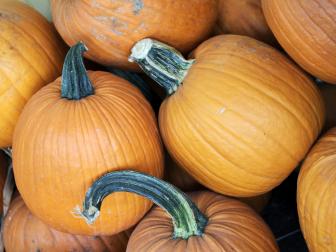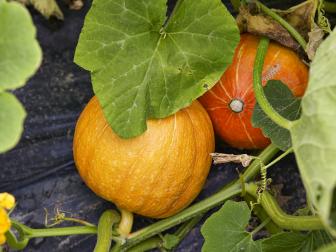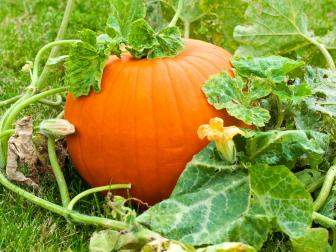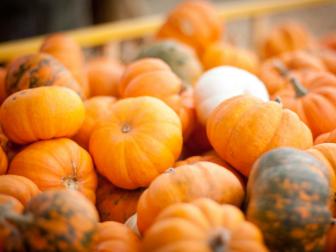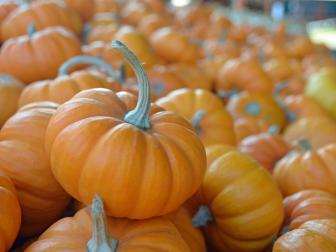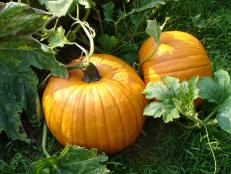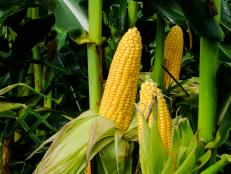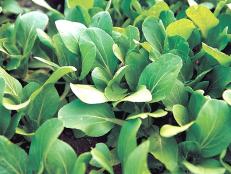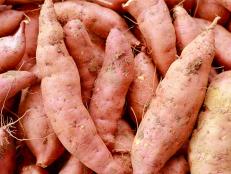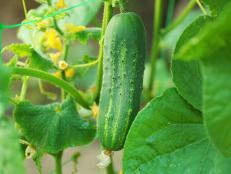How to Grow a Giant Pumpkin
Tips from giant-pumpkin experts Christy Harp and Jamie Johnson on how to grow a great big gourd.
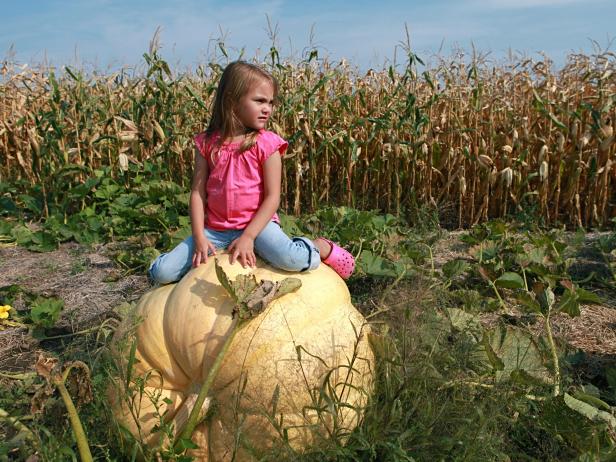

In the realm of high-stakes, big-drama gardening, nothing beats the giant pumpkin.
But while the world of competitive super-squash growing is a surprisingly serious one, learning how to grow a giant pumpkin isn't hard, and many winners of giant pumpking contests are more than happy to share their tips for great pumpkin success.
All About Pumpkins
Every fall, cities and townships across America dangle cash prizes before gargantuan-gourd growers in the quest for an ever bigger prized pumpkin.
And they just keep growing. In 2011, Napa, California grower Leonardo Urena garnered a nearly $22,000 paycheck, including an all-expenses-paid trip to New York City, for his 1,704-pound uber-gourd in the annual Half Moon Bay giant pumpkin contest. His secret? Loamy soil.
Getting Started
First, decide what you want: a large pumpkin for carving or decorating or a ribbon-earning giant. Large pumpkins may not earn you fame at the local pumpkin festival, but they’ll score big points with your family — and likely make your house the envy of the neighborhood for its homegrown harvest.
Follow planting instructions on the seed packet. As soon as vines start running or spreading along the ground, make sure your plants have enough water. Pumpkins are thirsty, and when you’re growing bigger fruits, you need to provide water if it doesn’t rain. Avoid using an overhead sprinkler, because that can spread diseases. Instead, use a soaker hose. As vines fill in, you won’t be able to see the hose, so don’t worry if it’s not the prettiest sight early in the growing season.
10 Pumpkin Varieties 10 Photos
Fall means only one thing: pumpkins, pumpkins and more pumpkins.
Check plants regularly for any signs of diseases or pests. Each leaf is very important and vital to producing large pumpkins. If you spot a problem on one leaf, it most likely will spread to another. Diagnose and treat problems as soon as you see them.
At each point along the stem where a leaf appears, a pumpkin vine can also produce secondary roots. Encourage these roots by heaping soil over stems beside leaves and watering for a week or two. Do this in a few places away from the main stem. Secondary roots help your vine support multiple large pumpkins simultaneously.
Pumpkin vines grow with one main vine and several branches. Keep an eye on the branches, and prune the tips of these vines when they’re 10 to 12 feet long. Bury the cut tips. Pruning the vines tricks the plant into sending more water and nutrients to the developing fruits.
To grow only a few large pumpkins, thin ripening fruit. An easy way to do this is to allow only one or two pumpkins to remain on each main branch of the vine. Use hand pruners to snip away stems of smaller pumpkins. Bury these in your compost pile or vegetable garden to feed worms and enrich soil.
Consider slipping a wafer of straw or an inverted terra-cotta saucer beneath young pumpkins to protect the ripening side from attack by soil insects. Harvest pumpkins when rinds show good color all over or just before frost, whichever occurs first.
12 Tips for How to Grow a Giant Pumpkin
To grow a big pumpkin, purchase seed that promises the harvest size you want. For modestly large pumpkins in the 25- to 35-pound range, search out seeds of the varieties Ol’ Zebs, Cinderella, or Gold Rush. If your sights are set on a 40- to 50-pound pumpkin, get seeds for Mammoth Gold, Burpee Prize Winner or Big Moon.
Think a giant gourd is out of your reach? Think again. With these tips from pumpkin experts Christy Harp, also a high school math teacher, and Jamie Johnson, a Denver web designer, you too can be fast on your way to joining the ranks of the big gourd growing elite.
- Great pumpkin lineage is key. If you want to grow a giant, you’ll need to procure seeds from a previous giant. Johnson and Harp both consider Atlantic Giant seeds to be the best of the best.
- Keep soil constantly moist but not soggy. Harp advises one inch of water per week if you don’t get adequate rainfall.
- Cover your pumpkin with a white sheet to protect it, advises Harp.
- Mild temperatures are best for growing pumpkins, with daily temps of 90 and nightly temps in the 60 range.
- Pump up your soil. Use lots and lots of rich compost and treat with fertilizer every other day.
- Prune your plants, says Harp, so energy is directed toward growing the pumpkin and not the vines.
- Grow one pumpkin per plant to make sure that the pumpkin gets the maximum amount of energy, says Harp.
- To protect your pumpkin from rotting, grow it on sand or on mill fabric, which will ensure that water can drain away, says Johnson.
- Plant seeds indoors in late April and transplant in early May to your garden, advises Harp.
- Bury the vines of your pumpkin plant a few inches deep, says Johnson. “The reason for this is to help anchor the plant down in windstorms. But more important, at each leaf node (where the leaf stems come out of the vine) the vine will produce a root out of the top and the bottom of the vine. If you have the vines properly buried you can have the entire planting area covered in roots, which will power the growth of the pumpkin,” says Johnson.
- Make it a family affair. Johnson recommends getting your children involved in your giant-pumpkin growing endeavors. Children love nothing so much as a contest. “I have also found that there are [life] lessons ... that the kids can relate to that you can pull from things like pumpkin growing,” says Johnson. “The opportunities to spend time with my children through pumpkin growing are invaluable.”
- Organic is best. Johnson likes organic fertilizers including compost, blood meal, myco and seaweed in lieu of chemicals.
Best Sources for Giant Pumpkin Seeds
Harp, a member of the Ohio Valley Giant Pumpkin Growers, offered to share the dried pumpkin seeds from her 2009 record-setting 1,725-pound prizewinner with anyone who asked. Schoolchildren from as far away as Hawaii requested Harp’s prizewinning seeds. And those seeds in turn helped grow a New Zealand prizewinner. If you don’t happen to know of a great pumpkin grower, purveyors like BigPumpkins.com offer giant-pumpkin seeds. Retailers including Burpee and Harris Seeds also offer access to potentially prizewinning progenitors.
Harp grew her first giant pumpkin when she was a teenager but really got the pumpkin-growing bug when she discovered her future husband, Nick, was a giant-pumpkin-growing fan. “Now we are married and share a patch but still keep our plants separate,” says Harp, who adds, “we do not agree on growing techniques!”
Ask the Experts for Pumpkin Growing Tips
Johnson, aka “the Pumpkin Man,” freely shares some of his best pumpkin-hatching tricks on his blog Denver Pumpkins.
“The surprising thing that you will find with giant-pumpkin growing is that almost all of the giant-pumpkin growers will give you their best seeds and tell you everything they know about giant-pumpkin growing if you ask them,” says Johnson. The appeal of growing prizewinning pumpkins is a combination of just that kind of camaraderie involved in pumpkin growing and a desire for personal challenges. “Every year my goal is to beat my previous best (currently 924.5 pounds),” says Johnson. “I won’t be satisfied until I get over 1,000 pounds. That should have happened last year but the pumpkin split open in late August and the growth went from 20 pounds a day down to about nine pounds a day after that.”
The phenomenal growth of pumpkins is part of the special-effects thrill of the process. Pumpkins can gain as much as 30 pounds a day, and once they are cut from the vine, big pumpkins lose an average of 6 to 8 pounds a day.
“Being able to go out in the patch and realize your pumpkin grew 40 pounds in a single day —it is almost as if you can see it growing. That is what makes it super fun,” says Harp.






